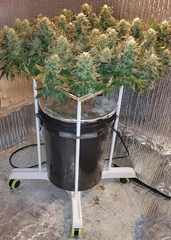ScrOG blOG™ — indoor growing
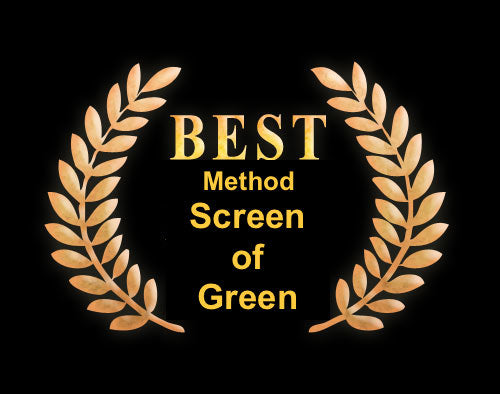
The Best Supporting Method
And The Best Supporting Method Goes To…
Screen of Green, For Its Starring Role In Marijuana Gardens Everywhere!
In our first article in this series, we outlined the screen of green technique and its pros and cons.
To recap, screen of green, or SCROG, was created by growers working with limited ground space and/or vertical height in their garden area. It’s useful for small spaces, and in situations when a grower can only grow a few plants.
SCROG growers train their plants’ branches to grow into and along a horizontal support screen that’s suspended above the plants.
Training the plants, known as low stress training, or LST, creates plants with multiple main branches that yield more bud weight. This form of marijuana growing is especially useful for maximizing yield per harvest.
The key component of a SCROG garden is the screen itself, which consists of a flat support structure to allow for horizontal mounting of screen material such as netting or string.
Two main types of screening apparatus have been popularized for SCROG cannabis cultivation. One type is fixed in place and mounted over a cannabis gardening system that might be a grow table, ebb and flow table, or deep water culture bucket system.
Multiple plants grow under the screen; their branches are woven or otherwise fastened to the horizontal screen.
Meet Scrogger, Innovators From The Lone Star State
Instead of that approach, we recommend the second style of SCROG cultivating, which involves having an individual plant in its own grow container served by its own apparatus.
This kind of growing is facilitated by the P SCROG system made by Scrogger, a company headquartered near Austin, Texas.
Scrogger specializes in SCROG gardening and has created state-of-the-art, multilayered, adjustable screen kits to fit almost any SCROG garden size or style.
P SCROG by Scrogger features a height-adjustable apparatus, several screen options, and a base that can support up to 250 pounds of weight. Said base is mounted on casters so the entire system and the plant within it can be rotated in a complete circle, and can be easily moved to another part of the grow operation.
This mobility and ease of access erases the disadvantages of SCROG gardens that have several plants growing under and sharing a large fixed screen, including difficulty with watering, trimming, even accessing the lowest parts of the plants in the middle of the arrangement.
Margo Mermelstein co-founded Scrogger in 2015 along with her husband Gary. The family-run business owns the patent for its revolutionary gadget that now sells nationally, as well as in Australia and Canada.
Margo explains, “Our unique selling point is the screens. They are, if you will, our secret sauce, because they are clear, flexible, reusable — and that’s what people like. Whether growers are using our portable units or the 2×4 or 4×4 [units], which are not portable, we’re finding the commonality that runs through all of it is our unique screen.”
Scrogger screens are made from polycarbonate, with an impressive flex strength of 13,500 PSI. You can almost bend this material in half and it won’t break.
They’re built to resist degradation factors common in indoor marijuana gardens such as water, nutrients, ultraviolet light and heat. They’re nonporous, washable and food-grade, meaning the polycarbonate doesn’t contain any dyes or recycled plastic that’s harmful to humans. In addition, the food-grade designation means no other harmful chemicals were used in either the resin or in production of the plastic container.
This is in contrast to materials commonly used as screens, supports and trellising in SCROG gardens. Growers often resort to DIY methods for constructing SCROG apparatus. Some SCROG growers use metal wire, string, cheap plastics, wood, PVC pipe and conduit for their plant supports. These materials cause a variety of problems including off-gassing, unstable supports, sagging, disease vectors, and transfer of harmful toxins into the plants.
Scrogger systems eliminate those issues. They’re elegantly engineered plug-and-play tools created specifically for serious growers, and can be customized to fit your budget and your needs.
Such patented systems allow maximum versatility as growers train their plants, because the gadgets can be precisely height adjusted as plants grow, and the systems also allow for stacking secondary screens above the primary training screen that sits closest to the root zone.
Check out the below YouTube video to see how to assemble a Scrogger system.
“[The screen is] great for people who have smaller number of plants, 12 or less, so they can turn them around, trim them — do all kinds of things, including adjust the screen’s height as the plant grows,” Margo continues.
“People who get up into 50 plants or more are looking to use our screens by themselves in higher configuration. It really depends on the individual and what they’re doing for their grow.
“Plus it’s great for people who are handicapped, because it gives them more flexibility.”
When you have a SCROG unit encasing each plant individually, the grower is afforded full access and is likely to enjoy superior gardening outcomes.
We recommend Scrogger because the engineering and materials are top-rank, and because the company’s customer service is excellent, as is it unusually comprehensive product warranties.
Especially for marijuana growers who haven’t cultivated crops with SCROG before, the Scrogger systems are much easier to assemble and use than other pre-fabricated or DIY plant support systems. These systems give you the ability to more easily and quickly maximize the benefits of this style of marijuana growing.
In our next articles about SCROG, we’ll take a deep dive into LST, as well as customized grow lighting, root zone and feeding techniques.

P SCROG Kits
or
SupportOurPlants@SCROGGER.com
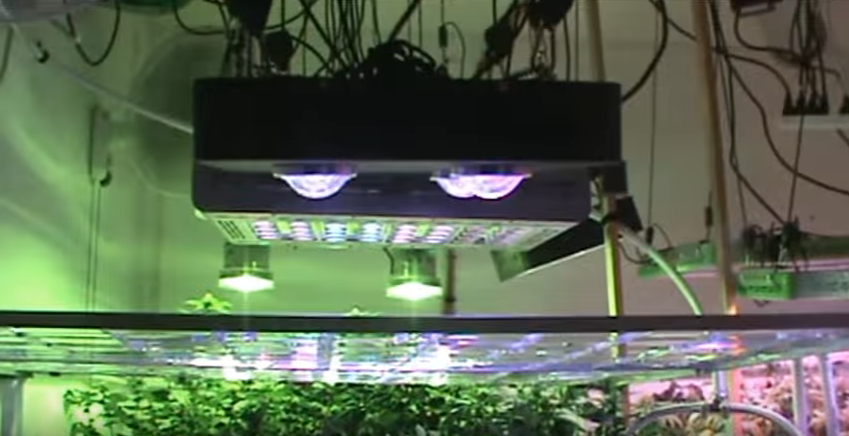
Colorado Finest Installs Double P SCROG 4x4

P SCROG Kits
or
SupportOurPlants@SCROGGER.com
- Gary Memelstein
- Tags: best how to scrog guides build a scrog colorado finest how to scrog indoor grow indoor growing low stress training P SCROG screens screen of green scrog scrog cannabis scrog kit scrog kits scrog marijuana scrog method scrog net scrog pot plants scrog screen scrog weed scrogging
Maximum Yield - SCROGGER Profile
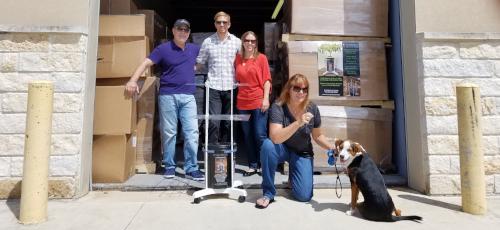
It all started when Gary offered to help solve the issues a friend was having with a DIY screen of green (ScrOG) set-up. Not only was this friend having trouble reaching all of his plants to do the low-stress training necessary for ScrOG, but his friend had “virtually destroyed” the whole set-up trying to solve a problem with one plant.
So, Gary scrapped the bamboo and trellis netting his friend was using and designed an accessible and versatile alternative out of clear polycarbonate. It didn’t take him long after that to recognize that this new design had the potential to fill a niche in the hydroponics market.
“Many want to ScrOG in a more-convenient, less-time-consuming and more effective way,” Gary says. “All of our products provide tremendous convenience to the grower who desires to use plant training techniques.”
Gary’s design, which is now sold as the P SCROG Primary and the P SCROG Pro, consists of one or two growing screens attached to a base by four supporting rods. The system’s base can accommodate 250 pounds and is wide enough for any container measuring between 10 and 22 inches. The whole thing sits on casters, which is a major selling feature. “Customers are enthusiastic about the benefit of being able to rotate the plant on the casters to trim, spray and care for their plants,” Gary says. “Some of our customers are disbled and can’t reach or lift as well as they used to, so being able to turn the plant is a huge advantage.”
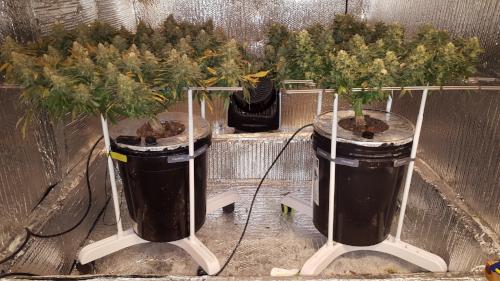
The screens on both P SCROG set-ups are also easily adjusted. Growers can raise or lower each by 12 inches, helping to force horizontal growth and to provide support for swelling buds. As mentioned above, the screens are made from polycarbonate—a tough, flexible material used in bullet-proof glass. “The flexural strength of this plastic is 13,500 PSI,” Margo says. “You should see the look on people’s faces when we flex the screen, they wince, expecting a snap; then they say ‘Wow!’”

In addition to the screens being strong, they are reusable, have a UV inhibitor, are non-porous and are food-grade. They provide a clean, almost clinical look in the growroom and are washable. They can also withstand temperatures far greater than you’d ever experience in the growroom. When they finally do wear out, the screens are 100 per cent recyclable.
To be sure they were bringing a viable product to the masses, the Mermelsteins knew they had to research the market. They had prototypes made in September 2014 and toured hydroponics shops in Phoenix and Denver to gather input from potential customers. As they hoped, the response was incredibly positive. At that point, they were ready to go for it. After incorporating the company in June 2015, they produced CAD drawings, filed a patent for their design and invested in the tooling needed to make plastic injection molded parts. It took nine months of engineering, but it was worth the effort when the first SCROGGER products were sold in January 2016.
“Since we launched the P SCROG, the most common comments we hear were things like, ‘Brilliant,’ or ‘I see how it works, no need to explain,’ or ‘I could really use something like that that,’” shares Gary. Similarly, Margo says they have not had a single customer complaint about the quality or assembly of their products. “Our main components to the P SCROG—the screens, base and junction caps—are molded right here in the USA,” she says. “The system is very well constructed with high-quality materials.”

Recently, the company expanded their lineup to include the P SCROG 4×4. This set-up is designed for growers with large, multiple plants using 4×4 or 4×8 trays and tables. These frames can be daisy chained together for large commercial applications.
In addition to their solid product line, great customer service has been one of the company’s strengths, with seven days a week support just a phone call or email away. “We are always happy to talk to shop owners and growers about the P SCROG,” says Gary.
Today, SCROGGER sells both on the web and in about a dozen hydroponic stores across the US, but they expect that number to grow rapidly. The company also works with a distributor in Canada and has its products in Australia. “We are adding more hydroponic stores every month,” says Margo.
While the Mermelsteins believe the hydroponic market is very different from their prior business experience, they feel the opportunities the industry presents are excellent, and they believe SCROGGER will play an important role in providing convenience and simplicity to growers everywhere.
*Original article published in Maximum Yield

P SCROG Kits
or
SupportOurPlants@SCROGGER.com
- Gary Memelstein
- Tags: growing cannabis hydroponics indoor grow indoor growing P SCROG screens scrog scrog kit scrog kits scrog method scrog net scrogging
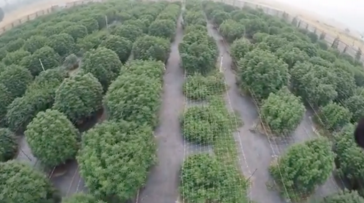
Okanogan Sunflower Farm

Like his great grandfather during the Gold Rush, Terry is in the midst of the "Green Rush" frenzy with his 28 acre Okanogan Sunflower Farm and "Okanogan Gold" cannabis brand of bud and extracts. "We can still pan for gold in the Okanogan River which is used for irrigation at the farm", says Terry. "We are located in north central Washington where the mountains meet the desert. This region and its micro climate are ideal for growing high grade cannabis plants."
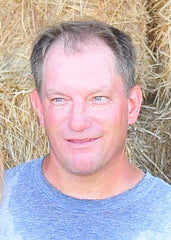
Hear Terry explain his cannabis operation in the YouTube video shot at the Okanogan Sunflower Farm, why he feels all plants should be ScrOGged and his predictions for the future of the cannabis industry. The drone footage is incredible. Please watch!

P SCROG Kits
or
SupportOurPlants@SCROGGER.com
- Gary Memelstein
- Tags: cannabis plant training growing cannabis how to scrog indoor grow indoor growing lollipopping low stress training lst outdoor grow screen of green scrog scrog kit scrog kits scrog marijuana scrog method scrog net scrog pot plants scrog screen scrog weed scrogging topping trellis trellis net
